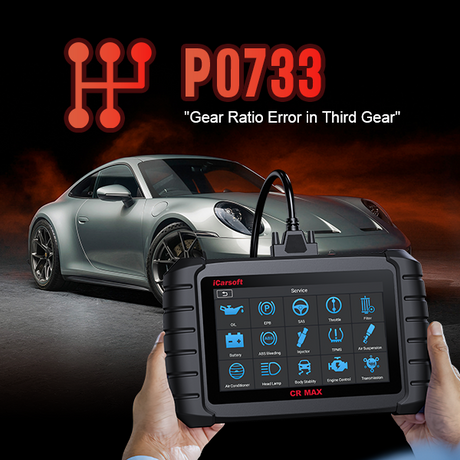The P0117 trouble code is an OBD-II diagnostic code related to the engine coolant temperature sensor. This code indicates a low voltage signal in the coolant temperature circuit, often leading to issues like poor fuel economy and engine overheating. This article provides a detailed guide on the causes, symptoms, and solutions for this diagnostic trouble code, with case studies from vehicles like the Honda Civic and Toyota Corolla. For related issues, explore our guides on P0116 and P0118.
1. What Is a Coolant Temperature Circuit Error?
The P0117 code, known as "Engine Coolant Temperature Sensor Circuit Low Input," is triggered when the Engine Control Module (ECM) detects a low voltage signal from the coolant temperature sensor (also called the ECT sensor). This sensor monitors the engine coolant temperature and sends data to the ECM, which adjusts the fuel mixture adjustment and ignition timing. A low voltage signal often means the sensor reports an abnormally low temperature, which can lead to improper engine operation in vehicles like the Honda Civic or Toyota Corolla.
Note: P0117 indicates a low voltage issue, while P0118 signals a high voltage problem, and P0116 points to inconsistent temperature readings, often within the same coolant temperature circuit.

2. Common Causes of Coolant Sensor Issues
Several factors can trigger a coolant sensor issue. Here are the most common causes, with real-world examples:
- Faulty Temperature Sensor: A defective sensor sends incorrect low voltage signals. For example, in a 2015 Honda Civic, the sensor failed due to prolonged exposure to high temperatures, causing this error.
- Wiring or Connector Problems: A short or open circuit in the wiring can disrupt the signal. In a 2017 Toyota Corolla, a frayed wire near the engine bay triggered the issue due to heat and vibration.
- Low Coolant Level: Insufficient coolant affects sensor readings. A 2016 Ford Focus had a coolant leak from a cracked hose, leading to inaccurate temperature data.
- ECM Malfunction: A faulty ECM may misinterpret the sensor signal. In a 2018 Nissan Sentra, an ECM software glitch caused the error, resolved with a firmware update.
- Corroded Connections: Moisture or road salt can corrode connectors. A 2019 Chevrolet Cruze showed this issue due to corrosion in the sensor’s connector.
3. Symptoms of a Coolant Sensor Problem
A coolant sensor issue can cause various symptoms, depending on its severity:
- Check Engine Light On: The most common sign is an illuminated check engine light on the dashboard, triggered by the ECM detecting a low voltage signal.
- Poor Fuel Economy: Incorrect fuel mixture adjustment leads to lower miles per gallon (MPG).
- Engine Overheating: An overheating warning may appear if the ECM fails to activate the cooling fan due to false temperature readings.
- Rough Idle: The engine may idle unevenly due to an improper air-fuel ratio.
- Difficulty Starting: The engine may struggle to start, especially in cold weather, as the ECM cannot adjust the fuel mixture correctly.
4. Vehicles Prone to This Coolant Error
This diagnostic trouble code often appears in vehicles with advanced engine management systems. Here are some examples:
- Honda Civic (2013-2018): A faulty temperature sensor caused the check engine light and poor fuel economy.
- Toyota Corolla (2012-2017): Damaged wiring led to rough idling and an overheating warning.
- Ford Focus (2014-2019): A coolant leak resulted in difficulty starting the engine.
- Nissan Sentra (2013-2019): An ECM software glitch triggered the code with no performance issues.
- Chevrolet Cruze (2015-2020): Corroded connectors caused engine overheating and reduced fuel efficiency.
5. Steps to Diagnose Coolant Temperature Issues
Diagnosing this issue requires a systematic approach. Here’s how to proceed:
Step 1: Read Trouble Codes and Data Stream
Use an OBD-II scanner like the iCarsoft CR MAX. Connect to the OBD-II port, retrieve the code, and monitor the temperature sensor data. For example, the sensor voltage should be between 0.5V and 4.5V; a reading below 0.5V indicates a potential short circuit.
Step 2: Visual Inspection
Check the temperature sensor, its connector, and wiring for damage, corrosion, or low coolant levels. If you’re not comfortable with this, a professional mechanic can assist.
Step 3: Test the Temperature Sensor
Use a multimeter to measure the sensor’s resistance. A normal ECT sensor should read 2-3 kΩ when cold (around 20°C/68°F) and 200-300 Ω when hot (around 90°C/194°F). If the resistance is 0 Ω, the sensor may be shorted.
Step 4: Inspect Wiring and Connectors
Test for shorts to ground or power using a multimeter, and check connectors for corrosion or loose pins.
Step 5: Verify the ECM
Test the ECM with a known-good sensor, and update its firmware if needed.
6. Solutions for Coolant Sensor Problems
Based on your diagnosis, apply these fixes:
- Replace the Temperature Sensor: Install a new sensor (e.g., a Honda OEM sensor for ~$50). Disconnect the connector, remove the old sensor, install the new one, and clear the code.
- Repair Wiring or Connectors: Solder shorted wires or replace damaged connectors.
- Refill Coolant: Add manufacturer-recommended coolant to the reservoir and radiator.
- Update ECM Software: Use dealer equipment to update the ECM firmware.
- Clean Corroded Connectors: Use electrical contact cleaner to remove corrosion.
For a visual guide, search online for videos like “How to replace an ECT sensor on a Honda Civic.”
7. Repair Costs and Key Precautions
Here are the estimated costs for fixing this issue:
- Temperature sensor: $50-$100
- Wiring repair: $50-$150
- Coolant refill: $20-$50
- ECM update: $0-$150
Precautions: Regularly check the sensor and wiring for damage, and ensure wiring is routed away from heat sources to prevent future issues.

8. Preventive Measures for Coolant Errors
To avoid future coolant temperature circuit issues, follow these tips:
- Inspect the temperature sensor and wiring every 6 months or 5,000 miles during routine maintenance.
- Replace the sensor every 60,000 miles or as recommended by the manufacturer.
- Use high-quality sensors and electrical components for replacements.
- Keep the engine bay clean to prevent contamination of sensors.
Tip: Regular maintenance can prevent issues in vehicles like the Honda Civic or Toyota Corolla. Always use the recommended coolant type, such as Honda Type 2 or Toyota Super Long Life Coolant.
9. Summary of Coolant Sensor Solutions
The P0117 trouble code signals a low voltage issue in the coolant temperature circuit. Through case studies—like a faulty sensor in a Honda Civic and damaged wiring in a Toyota Corolla—this guide provides a clear path to diagnose and fix the problem. Addressing this issue promptly prevents engine overheating and improves fuel efficiency. Tools like the iCarsoft CR MAX can help with real-time data and code clearing for optimal vehicle performance.













